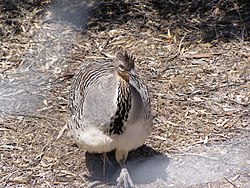Natural values

The reserve has a semi-arid Mediterranean climate with an annual average, mainly winter, rainfall of 282 mm. It protects York gum and salmon gum woodlands as well as heath and sand-plains. The old-growth woodlands contain tree-hollows suitable for many animals. Birds recorded on the reserve include malleefowl, Australian bustards, Major Mitchell's cockatoos, peregrine falcons, crested bellbirds, and the Wheatbelt form of the white-browed babbler. Mammals include short-beaked echidnas, euros and red kangaroos. [1]
Important Bird Area
The reserve, along with the neighbouring Mount Gibson Sanctuary, forms part of the 2335 km2 Mount Gibson and Charles Darwin Important Bird Area (IBA), so identified by BirdLife International principally because it supports populations of malleefowl and western corellas, as well as several other species restricted to either the arid or mallee biomes. [2]